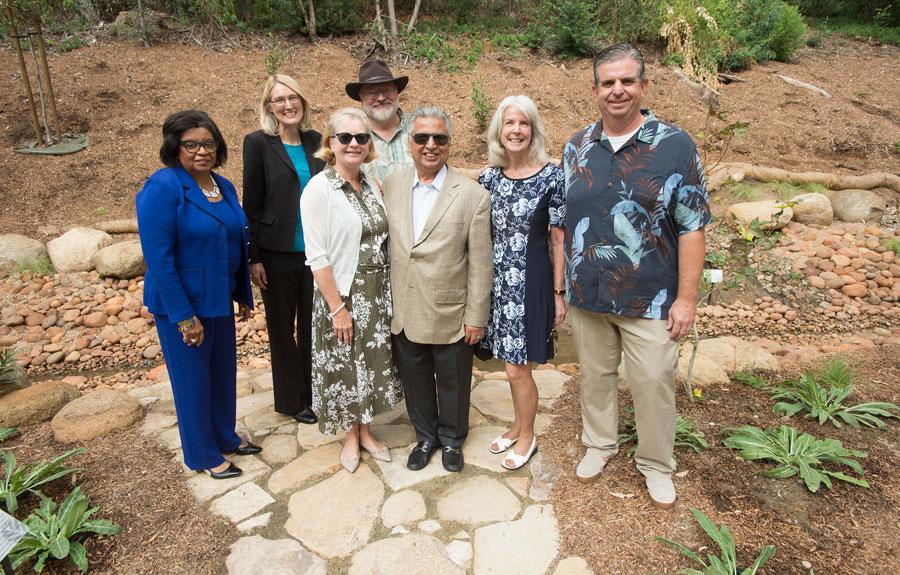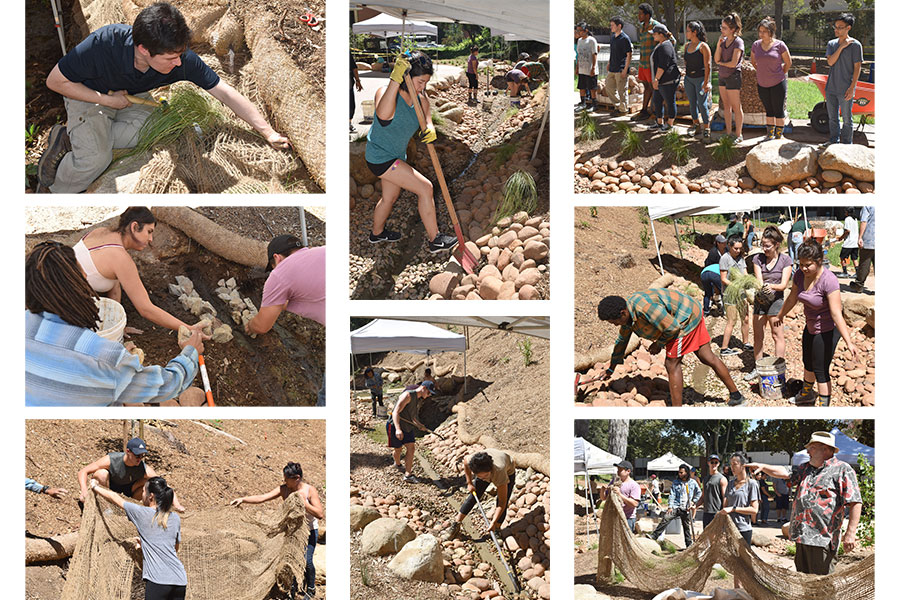Project Blue Reclaims Creek and Provides New Learning Opportunities

(President of the Ernest Prete Jr. Foundation Mohammad Virani and wife Carol (center) with (L-R) University President Soraya M. Coley, Dean Alison Baski, Rain Bird BioTrek Curator Mike Brown, Professors Tina Hartney, and Ed Bobich.)
Water is an essential element for life yet we take it for granted until there’s a shortage of it. For years people on the Cal Poly Pomona campus have walked from the parking lot behind Building One to University Drive oblivious of the natural springs they were passing by on their journey.
It took a water shortage for the existence of the spring to be brought to the attention of the campus community. In 2011 Biology Professors Tina Hartney and Ed Bobich were involved in a campus water initiative that got them thinking.
“At a time when we were concerned about water it was no small bit of irony that we had a natural source of water coming out of this spring, water that had sustained people and animals for years that was now going into a drain.” Bobich said.
“In that sense Project Blue is more of a restoration than it is a new development.” Hartney added.
Their vision was to uncover what they dubbed Lower Kellogg Creek and turn it into an outdoor learning environment. It wasn’t until 2015 that the College of Science secured the funding to realize that vision.
The Ernest Prete Jr. Foundation provided a gift of $200,000 that brought Project Blue to life. Mohammad Virani, president of the foundation, visited the campus and believed in their vision. “I saw the passion they had for this project and that it could provide a tremendous learning experience for students. Such experiences as these can be life-changing. The foundation also supported BioTrek and the Mesozoic Garden which have shown the value of such outdoor learning environments.” Virani said.
“Mr. Prete’s vision was ‘The spirit of this foundation honors significant proactive and imaginative activities regarding earth preservation and the exploration of the universe.’ Ernest Prete Jr. believed we ought to leave the world a better place. In support of that vision, we continue to partner with Cal Poly Pomona and help develop students who are making a difference in the world”
The project was designed by Studio-MLA. The architect, Claire Latané (‘06, master’s in landscape architecture), and Studio-MLA principal Jeff Hutchins (‘90, landscape architecture) are CPP alumni. Latané is also a lecturer in the College of Environmental Design. “It was a joy to work with a team that has such a connection to the land and knows the flora and fauna.” Latané said. “The walkway is curved to mimic the flow of water and the pebbles along one side are embedded by hand. This represents the transformation of rocks to sand through the force of water.”
Cal Construction and Development was the general contractor on the project. Inland Concrete Works was the subcontractor that did the hardscape and LandCare handled the landscaping.
Project Blue, which was dedicated September 25, will provide learning opportunities for students across campus. Bobich and Hartney already have curriculum planned around the site. “Students can study the evolution of life in riparian habitats and use the solar umbrellas at the site to power microscopes where they’ll examine the water that is teeming with life.” Bobich said.
“My Life Science (BIO 1110) class will study the importance of riparian habitats to life forms. But it’s not just about biology or science, every single department on campus has a connection to this project. There is conservation and sustainability, water rights, environmental design, and civil engineering involved, and art classes can capture the beauty of the site.” Hartney said.
University President Soraya M. Coley said, “One of the most exciting aspects of Project Blue is that it will bring K-12 students to the Cal Poly Pomona campus. In addition to enjoying a rich learning experience, these students also get to see a college campus firsthand. Regardless of their background, when these students come to our diverse campus, they see that they belong here. This special project holds the great potential to open the doors of college to even more of our region’s students.”
“Making science accessible is part of our Science For All initiative.” Dean Alison Baski, College of Science, said. “Thanks to Mike Brown, curator of Rain Bird BioTrek, students from several disciplines have been involved from the start.”
Brown, who joined the project in 2014, said, “Students from the colleges of science, agriculture, and environmental design helped clear the area of non-native plants and then carefully sculpted seep points, placed rocks, and planted native plants.”
The experience allowed students to learn by doing. Werner Abrego, who majors in urban and regional planning, said, “I really learned a lot by working on this. It was a creative experience because even though Mike provided direction, we were allowed the freedom to experiment and try different things to see what worked best.”
After the dedication Virani told a group of students that he was thrilled they had the opportunity to work on this project. “It’s something you’ll remember. You can be proud that you were a part of this. One day you may bring your children here and show them what you’ve done.”

(Students from the classes Interpretation of Science and Ethnobotany worked under the direction of Mike Brown to prepare Project Blue for the dedication on September 25, 2018.)
